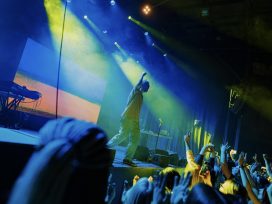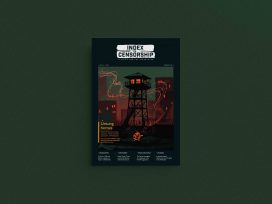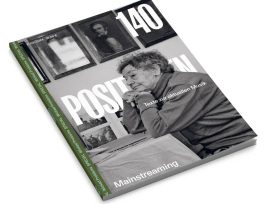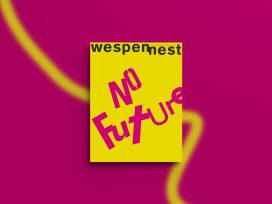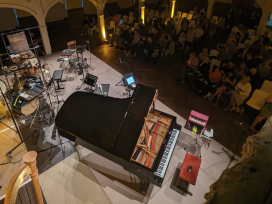Manfred Sapper: Frau Mutter, you have just come back from your Asia tour, where you played Beethoven and Mendelssohn, but also Wolfgang Rihm’s Lichtes Spiel and Sebastian Currier’s Time Machines. How is modern music received in China and Taiwan?
Anne-Sophie Mutter: Very well indeed. The audience there is well informed, and they are just as interested in contemporary music as audiences in Europe or the USA. There’s really no difference.
MS: You never had any contemporary music in your repertoire when you started out. You won your spurs with Mozart and Beethoven.
ASM: True, but I can still remember the very day I gave my first world premiere; it was 31 January 1986. I was playing with the Collegium Musicum, with Paul Sacher conducting, and the piece was none other than Witold Lutoslawski’s Chain II.
MS: Did you already know Lutoslawski at the time?
ASM: Yes, I’d known him since the early 1980s, as I became increasingly involved musically with the Swiss conductor and patron of the arts Paul Sacher, who had known my teacher Aida Stucki from an early age. Paul Sacher and his wife Maja lived in Pratteln, near Basel. Maja was the majority shareholder in Hoffmann-La Roche, the pharmaceutical company, and her main interest was the visual arts. Paul Sacher was patron for a great many composers, and used to commission a lot of pieces. Maja and Paul Sacher invited me to their home every now and then, where I met a great many painters and sculptors, but also all the composers who have written pieces for me since, apart from Sofia Gubaidulina. They wrote on commission from Paul Sacher, at first. I was terribly shy, but once I got over that I actually commissioned a few pieces myself. Anyway, I first met Witold Lutoslawski at the Sachers’ home. He awoke my interest in contemporary music. I would never have taken it as far as a world premiere though, except that one day in summer 1985 Paul Sacher turned up holding the score to Chain II in his hand and said, “Here’s a piece that Witold wrote, and the premiere’s in January”.
MS: What sort of impression did Witold Lutoslawski make on you?
ASM: I met him several times before the premiere, but at the time I just admired him from a distance. For me, the world in which creative artists live has always been very mystical, very special, a world apart. When I meet them, I never try to chum up with them. There was something quite angelic about Witold Lutoslawski, a purity about him. And I find that in his music, again and again. He would never have dreamed of making grand gestures. He was devoted to form and expression. You could see that in his personality as well. This impressed me deeply, right from the start, and I felt humbled as well.
MS: But by the sound of it, you were no longer admiring him from a distance…
ASM: That’s right, we actually developed a wonderful friendship – although it was all too short, alas. The high point came when Witold was a guest at my wedding in January 1989. He wrote me a little lullaby as a wedding present. Even back then, I had trouble sleeping. This I have had all my life. Obviously he suffered from insomnia as well from time to time, since he wrote on the score, “In case you can’t sleep read this”. I thought that was wonderfully kind of him. The lullaby has become part of my recital repertoire. I play it very often as an encore.
MS: When you were awarded the Ernst von Siemens music prize in 2008, you recalled the premiere of Lutoslawski’s Chain II in January 1986 in your acceptance speech. You said at the time, “This was the beginning of a new era for me. It opened my ears to a new cosmos”. What was particularly new in this musical cosmos?
ASM: For me, what was new was discovering the language of contemporary music in general. Lutoslawski had opened the window to the future for me. It couldn’t have been better. For me, he was a composer who could strike a chord within me that had always been there, but which I had never heard before in any other work I knew. None of them had these tender moments of non vibrato that I first found in Lutoslawski’s music, this whole world between piano and the moment when sound arises from nothing, which fascinated me at the time and still moves me very deeply today. It was also quite new to me how much room he leaves for the performer’s own creativity. We don’t make anything completely new, but in his work, the performing artist has a creative part to play. As early as the 1960s he had developed the form of the ad libitum…
MS: …that’s an instruction in the score that gives you, the soloist, more freedom to choose which tempo to play at, for instance…
ASM: Not just me as the soloist. It’s all down to Lutoslawski’s realisation that we musicians, and the orchestra in particular, very often have to follow every twitch of the conductor’s baton. To an extent, this can set limits to each and every musician’s freedom to interpret the work, whether we are the soloist or sitting in the orchestra. But ad libitum playing doesn’t mean anarchy in the score. Rather these are very deliberately composed musical sequences. But it’s left entirely to each player when he chooses to start playing, how many times he plays his part, and which tempo to use. I can speak from experience here and say that I have never known such freedom and freshness of expression as when I got to know this new structure of the ad libitum movement, this dialogue between the piano solo in the orchestra and the solo violin, with the two of them having real freedom to shape the piece especially in the Partita. And the more I play this work, the more strongly I can express that freedom and freshness.
MS: Did Lutoslawski grant you this freedom in person, or did you find it for yourself as you studied his score?
ASM: A musician gets to know the score on her own first, of course. I can remember all I went through that summer of 1985 very clearly. At first came a stretch of painfully hard work, since I barely knew how to begin with the hieroglyphics in the score. But then the marvellous tones and colours of Lutoslawski’s music opened up the score for me, and I saw it quite clearly and found its emotional meaning. I was enchanted, and I still am today.
MS: Did Lutoslawski enrich the way you perform?
ASM: Without a doubt. This is true for every contemporary work I have had the privilege of premiering, though.
MS: What do you see as the greatest difference between playing a violin concerto by Mozart or Beethoven, and a piece by Sofia Gubaidulina, Wolfgang Rihm or Krzysztof Penderecki?
ASM: Even though we might like to free ourselves of all preconceptions, the first point is that the classical repertoire is very strongly influenced by traditional attitudes and expectations. Contemporary music doesn’t have to carry that burden. The other point is that with contemporary composers, I can always ask questions. That way perhaps I can get closer to the right performance style – if such a thing exists. What I have always found interesting about tackling a living composer’s work, or having a personal conversation with them, is the openness to various different ways of performing. This gives us much greater freedom as performing artists than seems possible in the classical repertoire. The main school of thought there is to play it safe, which unfortunately seems awfully popular these days. It’s as though they are looking for a formula: if it’s worked once before, and it was a success, then it must be the right way to do it. That’s a fatal philosophy for performing artists. You can clear all such thoughts from your head as soon as you talk to a composer. And by the way, this opens up some very interesting interpretations of the musical past. There’s plenty of evidence in the literature about Mozart’s performing style. Even in the eighteenth century, we can read how wildly and passionately Mozart performed from his own scores, or Bach even earlier, and how different the music sounded every time. Then on top of that, we have an established practise of improvisation ever since. I don’t understand why there has to be just one right way to do it in the classical repertoire today.
MS: Earlier you emphasised Lutoslawski’s importance for modern music. Do you share my feeling that Lutoslawski has largely vanished from the concert halls today?
ASM: I don’t know what’s played in concert halls worldwide. But sadly, you could be right. Even when a great composer dies, that doesn’t mean that his work will continue to be played as much as before. After all, there are other composers still alive, some of them conducting their own works. Think of Lutoslawski’s compatriot Penderecki, or the great Pierre Boulez. It’s down to us as performers, in the first instance, to keep Witold Lutoslawski’s memory alive. Witold’s hundredth birthday is a wonderful opportunity to remember him once again. I am a true believer in his works, I always have been, and I love playing them as often as I can. Tragically we only had a few years together before he died. I know that he was working on a violin concerto for me, but it wasn’t to be. Which is why I’m all the more grateful that he wrote a second work for me, the orchestral version of his Partita. And above all we mustn’t forget the Interludium. He conceived it deliberately for performances of Chain II and the Partita together as self-contained halves of one concert, so he created this short piece for solo and orchestra as a bridge, so to speak, uniting these two works. I’m very happy that there’s finally a CD of the Interludium, so that listeners can recognise how the whole complex works together.
MS: You are giving three tours in 2013, and playing Lutoslawski on each one. Can we assume that you tell the concert organisers what you are going to play?
ASM: (laughs) Yes, all the time! It’s quite normal for a performer to suggest a programme of personal favourites from their ever-growing repertoire. And contemporary music has given me some of my very favourite pieces. I have always had the great good fortune to find allies and supporters here, whether these are fellow musicians, or impresarios, or in particular a loyal public who trust my instincts.
MS: You have given about twenty world premieres since 1986. As well as Sebastian Currier, Sofia Gubaidulina, Wolfgang Rihm and Krzysztof Penderecki, whom we have already mentioned, there have been pieces by Henri Dutilleux, Norbert Moret and André Previn. Some have even called you a “midwife” of contemporary music. It seems to me though that you are committed to a particular strand of contemporary music. All these composers write in the tradition of bel canto. They use the strongly lyrical side of the violin. There are composers though like Luigi Nono or Helmut Lachenmann, who are writing radical experiments with sound and tonality, questioning or even doing away with traditional concepts of music based on tonality and pitch. They don’t feature in your repertoire however. Why is that?
ASM: This is a dangerous comparison to make, since you cannot reduce a composer like Lachenmann simply to sound-experiments or alienation effects. I feel anyway that people are far too fond of simple schematic classification in music, for instance I have a quarrel with the division into Classical and Romantic. This just pigeonholes the music! It’s true that the works written for me are very strongly rooted in the bel canto, which was the composers’ own decision. But they are not just that: take Krzysztof Penderecki’s second violin concerto, Metamorphosen, or in particular take Sofia Gubaidulina’s In tempus praesens. It has an enormous range of expressive forms. The main theme is about the destruction of the goddess Sophia, but it is a very autobiographical work, dealing with the difficulties that Gubaidulina had under the Soviet regime. There is terror and despair in the work, darkness, but also the Romantic element – the way out of that darkness into light.
In all the works written for me there have been shadows and dissonances. But the violin itself as an instrument clearly makes the composers yearn for the light, and work towards it – and also for song. And I find that very beautiful. Reality is dreadful enough. Why shouldn’t we use music to find our way upwards?
MS: Since you warn of schematic classification into schools or eras, you probably also have little patience with the idea of “national music.” Or have you got to know “Polish music” through Lutoslawski ?
ASM: Would we want to say that Antonin Dvorak only belongs to the Czech school? Wasn’t he invited to invent a new American musical language, in America? And wasn’t his New World Symphony well-received? Dvorak is rightly seen as someone who used a fully-realised American tonal language in his music, with influences from the American Indians, from plantation slave songs, Gospel and jazz. I think when all’s said and done, every composer is his own cosmos. Naturally the cultural influence of their home country plays an enormous role. But Lutoslawski did not just work in the Polish symphonic tradition, he was also strongly influenced by Claude Debussy and Maurice Ravel, so much so that he was probably the most impressionistic composer of his generation.
MS: Where did his fondness for the French come from, in fact? It goes so far that he even gave many of his pieces French titles.
ASM: That’s right. He frequently mentioned that he felt his work was rooted in Debussy. I think that he meant his search for subtleties of tone and timbre, the finest possible nuances of orchestration.
MS: These days contemporary composers from Eastern Europe have complained that even twenty years after the fall of the Iron Curtain, it’s still difficult for them to have their works performed in concert in the West. Do you think these complaints are justified?
ASM: No, not in the least. The problem is quite different. Sofia Gubaidulina for instance was a prisoner in her own country for decades, as an artist, since she refused to go on foreign tours that would serve the Soviet Union’s propaganda machine. If a composer can’t travel, then his music too has a hard time getting out into the world. But this has nothing to do with Western unwillingness to hear the work. We also need great impresarios and performers, such as Gidon Kremer. It’s entirely down to him that Sofia Gubaidulina’s star began to rise in the 1980s, all around the world. Before then we hardly knew anything about her.
MS: What hopes do you have for the Lutoslawski anniversary year in 2013?
ASM: I hope that when orchestras approach this repertoire, they develop much greater sensitivity for tonality, just as they always need when they play Mozart and Haydn. Lutoslawski’s music demands a great deal of sensitivity and an understanding of multiple aspects of the work, it needs fine phrasing and a specific inner balance in an orchestra. We should be ready to hear music that unfolds from silence. We really need such music, since the world is very loud indeed. At the moment the dominant repertoire consists of crowd-pleasing, loud pieces.
MS: Which of Lutoslawski’s pieces will you play?
ASM: For his birthday on 23 January I will be in Warsaw, playing both of the pieces that are dedicated to me – and I’ll play them with the Warsaw Philharmonic Orchestra under Antoni Wit. Then I will be setting off on a small European tour, where I will play the orchestral version of the Partita. I was already playing it this autumn, in preparation for his centenary. I will also play it in spring 2013 in Japan, in honour of Witold Lutoslawski, to celebrate his work and make him better-known in a part of the world where he is not so much at home as in Poland, Germany and the Anglo-Saxon countries. The Partita is an immensely exciting work as well, just wonderful.
